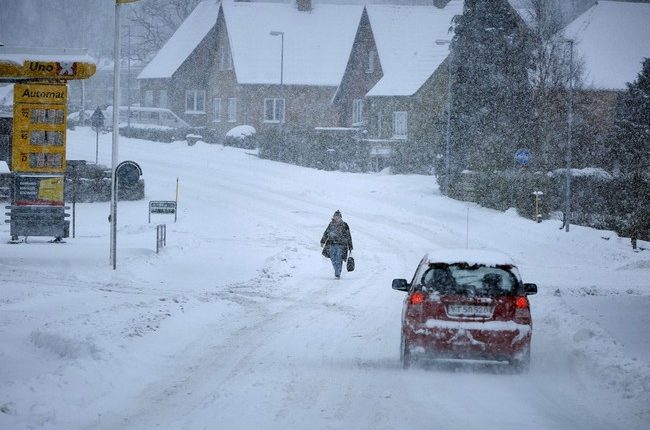
I find this to be a really fascinating – and encouraging – turnaround.
Forty years ago this past March, Denmark banned nuclear power outright and sold their virtue-signalling, collective soul to the Green grifters.
On this day, 40 years ago, Denmark banned nuclear power over vibes
Since then 🇩🇰
🏭 Burned coal for decades
❌ Helped shut down reactors abroad
🤫 Quietly imported nuclear
🤥 Became a climate hypocriteThis is the story of one of the most self-defeating energy policies
A 🧵
1/9 pic.twitter.com/M69xn0Uk5k— Johan Christian Sollid (@sollidnuclear) March 29, 2025
Going all renewables, sort of.
Over half of the country’s power generation is ‘from wind,’ but we all know wind doesn’t blow all the time. So what happens to the Danes then?
Oh, well, lucky thing Norway has lots of water for hydroelectric plants, that neighboring Sweden wasn’t as fussy about having nuclear plants on their soil, and that Danes have lots of geld to pay for it.
Because they pay out the wazoo to cover what the wind won’t do and to cover generation capacity the country phased out and never replaced.
…Robust connection between Norway’s hydro turbines and West Denmark’s wind turbines holds the key to successful exploitation of wind for Denmark, and the German and Swedish connections are nearly as importantc. The power imported from Sweden is about 40% nuclear and 40% hydro. About 45% of the power imported from Germany is from coal or natural gas. Norway is almost all hydro.
The wind turbines depend heavily for their effective utilization on over 30 GWe of hydro capacity in Norway, over 1.7 GWe of which can be dispatched promptly when wind power is unavailable in West Denmark. The Skagerrak HVDC link is owned and operated by Statnett in Norway, and Energinet.dk in Denmark. Hence, there is a natural and felicitous interdependence between West Denmark’s wind and Norway’s hydro. With good winds, power can be exported back to Norway and conserve hydro potential thered. This explains why the net import-export balance of electricity with Norway is variable.
Although about half of the electricity produced in Denmark is from wind, the country’s use of this electricity is lower in any given year. A 2009 report by Danish policy think tank CEPOS estimated that Denmark consumes around half of its wind-generated electricity on averagee, 1.
Denmark’s generation of electricity declined by over 30% between 2006 and 2020 (see table below) as coal has been progressively phased out, and the government has focused on energy efficiency. Domestic generation has been in part replaced by increased imports of electricity, principally from Norway and Sweden.
All in all, a brilliant plan. The country uses wind turbines for approximately fifty percent of its energy needs and purchases imported energy from its neighbors. That power is generated using every last method Denmark banned in the name of saving the planet and paying a premium for the virtue signaling, hypocritical privilege.
Instead of doing something about it, the government has always urged Danes to be thriftier. Learn good conservation habits from the pain of wild price spikes since they won’t be dropping any of the big, fat utility taxes anytime soon.
…Consumers can take a number of steps to avoid the worst impacts on household finances of this week’s peaking prices.
“We must rediscover good saving habits from the time of the energy crisis, check prices on our apps and use electricity at outlying times of day,” Brøgger said.
The Confederation of Danish Industry (Dansk Industri, DI) took a skeptical view of the high current prices.
“The electricity price will today hit one of the highest levels ever and that will have an impact on Danes’s wallets,” deputy director Troels Ranis told Ritzau.
“At the same time, Danish electricity taxes are among the highest in Europe – and are also higher than on any other form of energy, which is why bills will be higher than necessary,” he stated.
The organisation is calling for electricity taxes to be reduced “as soon as possible,” Ranis said.
WEEEE!
Such fun.
It is all part and parcel of the costs of living the subsidized, unreliable, renewable life for a tiny country that once had three nuclear reactors of its own.
…Denmark has had a wide range of incentives for renewables and particularly wind energy, accounting for nearly one-third of total wholesale electricity prices. Apart from the Purchase Obligation (PO) for renewables providing an effective subsidy, there is a further economic cost borne by power utilities’ customers. When there is a drop in wind, back-up power is bought from the Nordic power pool at the going rate. Similarly, any surplus electricity is sold to the pool, though it is deemed to be non-PO power. The net effect of this has been increased costs as wind capacity expanded.
It’s the same story everywhere when wind and solar go crazy and generate power surpluses.
France has to pay renewable generators to curtail production if the system is oversupplied
The weather dependent energy sources flood the market with power that is not needed, destabilizing the grid, and are then compensated to stop it
There’s something wrong with that https://t.co/ZrzKrjiUDw
— Jens Christiansen (@jenshigh) April 16, 2025
Those are expensive, too.
After forty years, with nothing ever getting less expensive or more reliable, the Danish people are starting to look at nuclear power with fresh eyes and a little less jaundiced approach.
Maybe it’s not the devil after all, and they are willing to put their money into the pot to pursue it.
Denmark is launching a new nuclear power fund aiming to raise €350 million to support the development of small modular reactors and advanced nuclear technologies. This initiative comes as the country seeks to diversify its energy mix and meet growing electricity demands driven by the expansion of data centres and the electrification of heavy industries.
Data centres, which require vast amounts of electricity to power and cool their operations, are a significant factor in the rising demand. The global surge in artificial intelligence applications has further intensified this need, as AI models necessitate substantial computational power. In Denmark, major tech companies are planning to build large-scale data centres, with some projects aiming to consume up to 960 megawatts of electricity. This escalation in energy consumption is challenging the capacity of existing renewable sources to meet demand consistently.
The cultists were immediately up in arms – ‘Nuclear is a dead end,‘ said one opponent group. But these are the same arguments they’ve used for forty years.
…However, the initiative has faced criticism from environmental groups and some political factions. Opponents contend that the focus should remain on expanding renewable energy sources and improving energy efficiency rather than investing in nuclear power. They express concerns about the long-term management of nuclear waste and the high costs associated with nuclear infrastructure.
Interestingly enough, it seems the pro-nuclear forces have some political heft on their side this time.
Venstre’s new position comes less than 24 hours after another government party, Moderaterne, publicly backed nuclear energy.
Originally proposed by @SteffenFrolund from @LiberalAlliance, the nuclear ban will eventually fall. It is inevitable!
2/2https://t.co/3serIM3HGr— Johan Christian Sollid (@sollidnuclear) April 26, 2025
Approval of nuclear is now at 55% in Denmark and rising, I would imagine, with every utility bill.
Or with every shocking country-wide outage, much like the Spanish, Portuguese, and some French experienced yesterday, many of whom are still without power today.
It’s bad enough when your juice is expensive. The last thing your country needs is for the grid to be fragile as well, and renewable grids, by their very nature, are.
This could well be yet another reason for a shift in the wind direction towards nuclear in the Danish parliament.
…Over the weekend, first Moderaterne and then Venstre announced that they want the 1985 ban on nuclear power lifted.
An interesting conflict to watch
That’s two out of three government parties. That bodes for an interesting conflict, because the third and largest government party, the Social Democrats, is not in favor of nuclear power.
“Venstre is working to abolish the ban from 1985, which means that nuclear power must not be included in Danish energy planning. At the same time, we will work to remove any barriers to research into nuclear power technologies in Denmark,” the leader of Venstre, Troels Lund Poulsen, writes in a comment to Ritzau.
Since other right-wing parties such as Liberal Alliance, Konservative and Dansk Folkeparti are also in favor of abolishing the ban, they have called for a debate in Folketinget with a proposal that the ban on nuclear power be lifted.
“We want to strike while the iron is hot and get over the hump now,” says Liberal Alliance climate spokesman Steffen Frølund to Ritzau.
The Social Democrats may find themselves out in the cold and dark if every other party votes to open the debate.
With a solid majority of Danes already agreeing on nuclear, they may not have much of a choice.







